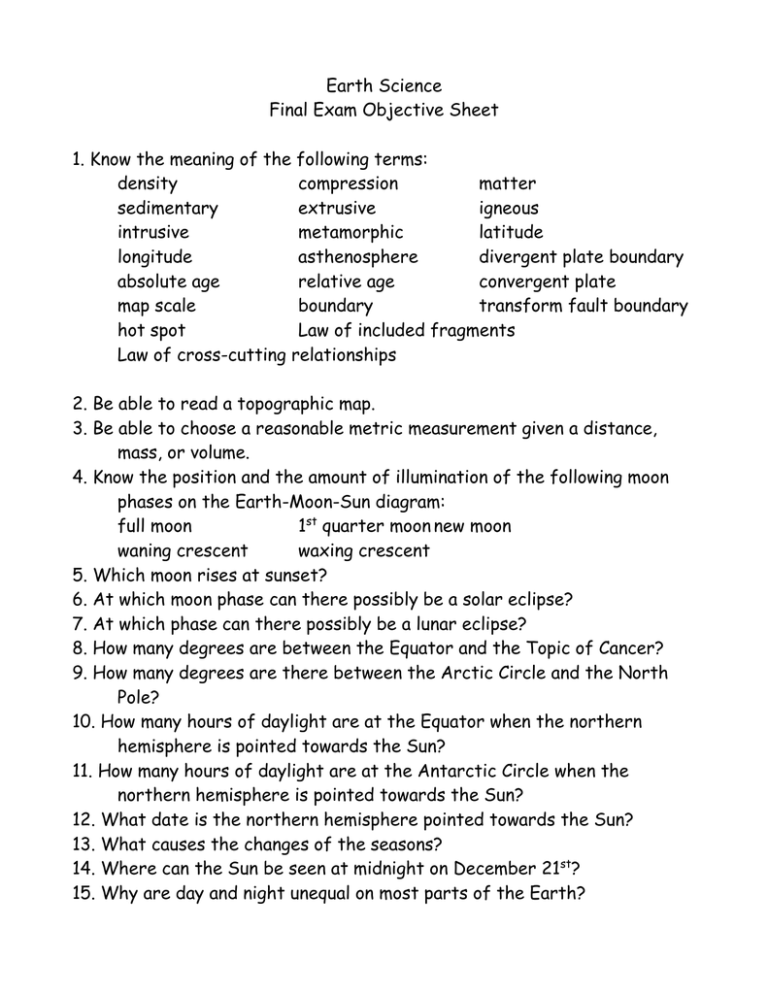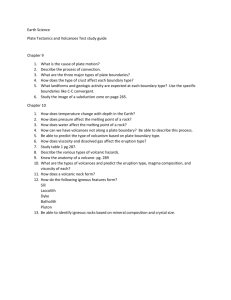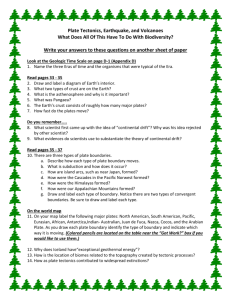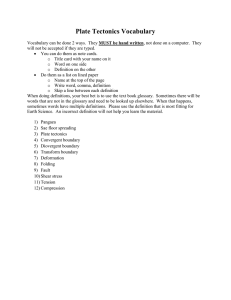Earth Science Final Exam Objective Sheet
advertisement

Earth Science Final Exam Objective Sheet 1. Know the meaning of the following terms: density compression matter sedimentary extrusive igneous intrusive metamorphic latitude longitude asthenosphere divergent plate boundary absolute age relative age convergent plate map scale boundary transform fault boundary hot spot Law of included fragments Law of cross-cutting relationships 2. Be able to read a topographic map. 3. Be able to choose a reasonable metric measurement given a distance, mass, or volume. 4. Know the position and the amount of illumination of the following moon phases on the Earth-Moon-Sun diagram: full moon 1st quarter moon new moon waning crescent waxing crescent 5. Which moon rises at sunset? 6. At which moon phase can there possibly be a solar eclipse? 7. At which phase can there possibly be a lunar eclipse? 8. How many degrees are between the Equator and the Topic of Cancer? 9. How many degrees are there between the Arctic Circle and the North Pole? 10. How many hours of daylight are at the Equator when the northern hemisphere is pointed towards the Sun? 11. How many hours of daylight are at the Antarctic Circle when the northern hemisphere is pointed towards the Sun? 12. What date is the northern hemisphere pointed towards the Sun? 13. What causes the changes of the seasons? 14. Where can the Sun be seen at midnight on December 21st? 15. Why are day and night unequal on most parts of the Earth? 16. Why do day and night alternate every 24 hours? 17. Which plate tectonic boundary produces the fewest of the world’s volcanoes? 18. What is the source of magma for volcanoes at divergent plate boundaries? 19. How does temperature affect viscosity of lava? 20. What are mid-ocean ridges? 21. Where are the youngest rocks on the ocean floor found? 22. At which type of plate boundaries are volcanoes found? 23. What happens to the temperature of a substance when it is compressed? 24. What changes occur to a substance when it is heated? 25. In what environment would you most likely find the rock conglomerate? 26. How can you get solid crystal out of a solution? 27. How is the streak of a mineral most easily obtained? 28. Describe the types of environments/conditions you would find: igneous rocks sedimentary rocks metamorphic rocks 29. What type of crystals result in slow cooling of magma? 30. What does scale on a topographic map tell? 31. How do you find the shortest path between two places on earth? 32. How was the island chain of Hawaii formed? 33. What types of plate boundaries are associated with deep earthquakes? 34. What are some features of places where the following are found? Divergent plate boundary Convergent plate boundary Transform fault boundary Hot spots 35. Be able to identify specimens of: igneous rocks sedimentary rocks metamorphic rocks






